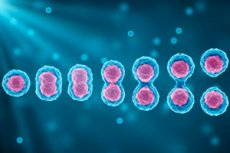New publications
Stem cells and their exosomes: breakthrough approaches to treating age-related diseases
Last reviewed: 09.08.2025

All iLive content is medically reviewed or fact checked to ensure as much factual accuracy as possible.
We have strict sourcing guidelines and only link to reputable media sites, academic research institutions and, whenever possible, medically peer reviewed studies. Note that the numbers in parentheses ([1], [2], etc.) are clickable links to these studies.
If you feel that any of our content is inaccurate, out-of-date, or otherwise questionable, please select it and press Ctrl + Enter.

Scientists from the Tohoku Medical Megabank Organization at Tohoku University (Japan) have prepared the most comprehensive review to date of the use of mesenchymal stem cells (MSC) and their exosomes (MSC-Exos) to correct age-related physiological disorders and treat age-related diseases. The work was published in the journal Stem Cell Research & Therapy and covers data from more than 150 publications over the past five years.
Why MSCs and their exosomes
Mesenchymal stem cells obtained from adipose tissue, bone marrow, umbilical cord blood or placenta are capable of:
- Differentiate into various tissues (bone, fat, cartilage).
- Secrete a wide range of trophic factors (VEGF, HGF, IGF-1) that regulate proliferation, angiogenesis and immune response.
- Migrate to damaged areas via SDF-1/CXCR4 chemotaxis.
Their exosomes (30–150 nm) carry proteins, lipids and microRNAs, replicating the key effects of MSCs without the risk of tumorigenesis, thrombosis or immune complications.
Main areas of application
1. Premature ovarian failure (POF)
- Preclinical models: mice and rats with chemo- or radiation-induced POF.
- MSC mechanisms:
- Stimulation of granulosa cell proliferation via the PI3K/AKT and Wnt/β-catenin pathway.
- Reduction of oocyte apoptosis by suppression of PTEN/FOXO3a.
- Results: restoration of estrogen levels, reduction of follicular atrophy and normalization of the menstrual cycle in models.
- Exosomes: deliver miR-21, miR-146a and miR-29, which suppress pro-inflammatory signals (TGF-β1/Smad3) and protect the follicular cell.
2. Alzheimer's disease (AD)
Models: APPSwe/PS1dE9 transgenic mice and β-amyloid injections.
MSC Action:
Secretion of neurotrophins (BDNF, GDNF) and activation of the PI3K/AKT pathway, which protect neurons from apoptosis.
Increased activity of M2-phenotype microglia, accelerating phagocytosis of β-amyloid.
Exosomes:
Delivers mitochondria precursors and let-7, increasing neuronal energy metabolism.
Reduce τ-phosphorylation via SIRT1/AMPK modulation.
Effect: improved memory and learning in a maze task and a reduction in β-amyloid deposits by 40–60%.
3. Atherosclerosis
- Preclinical: ApoE–/– and LDLR–/– mice on a high-fat diet.
- MSC and exosomes:
- Reduces the expression of VCAM-1, ICAM-1 and MCP-1 through suppression of NF-κB.
- Stimulate angiogenesis in the ischemic limb due to VEGF and Ang-1.
- Result: reduction in the volume of atherosclerotic plaques by 30%, improvement in blood flow and reduction in systemic inflammation.
4. Osteoporosis
- Models: ovariectomized rats and aged mice.
- MSC: activate Runx2, OPG/RANKL and Wnt signaling to enhance bone matrix formation.
- Exosomes: enriched in miR-196a, miR-21, miR-29b, increase osteoblast proliferation and decrease osteoclast activity.
- Results: increase in bone mass and strength by 25–35% compared to the control.
Benefits and Challenges
Pros of exosomes
- No risk of teratoma and immune rejection.
- Easy standardization of breeding and storage.
- Ability to cross the blood-brain barrier.
Key tasks
- Targeting: modification of the exosome surface with ligand peptides (RGD motif) or antibodies for delivery to specific tissues.
- Pharmacokinetics: study of circulation time and organ distribution using in vivo methods (MRI, fluorescence).
- Scaling: Developing GMP protocols for exosome production with consistent quality and potency.
- Safety: Long-term toxicology studies in large animals to evaluate accumulation and effects of accumulated material.
Prospects for clinical translation
The authors predict that clinical trials of MSC-Exos for age-related disorders will begin in the next 3–5 years:
- POF: early phase I/II trials to evaluate fertility restoration in women with chemo-induced POF.
- AD: Phase II study on cognitive function in early stage patients.
- Osteoporosis and limb ischemia: assessments of bone strength and ulcer healing.
In the discussion, the authors highlight several key points:
Advantages of exosomes over cells:
“MSC exosomes combine the therapeutic potential of MSCs themselves with improved safety and standardization,” notes Dr. Katsuki Yamanaka. “They do not divide or form tumors, making them more predictable in clinical use.”The need for targeting and preconditioning:
“To maximize efficacy and minimize side effects, we need to tailor the exosome surfaces to specific tissues and pre-heat the MSCs under mild stress conditions so that the exosomes carry enhanced protective signals,” says co-author Prof. Hiroto Nakamura.Potential in combination approaches:
“Combining MSC exosomes with small molecule drugs or penetrating exercise protocols may provide a synergistic effect in age-related diseases,” adds Dr. Ayako Sato.Clinical translation perspective:
“We are on the cusp of launching the first phase I trials of exosomes in premature ovarian failure and osteoporosis,” announces lead author Dr. Takeshi Iwakura.
These comments highlight that despite encouraging preclinical results, the success of clinical application of MSC-exosomes depends on addressing the challenges of targeted delivery, standardizing manufacturing, and confirming safety in large trials.
According to the authors, multidisciplinary collaboration between cell biologists, bioengineers and clinicians will allow for the rapid and safe introduction of MSC exosomes into therapeutic protocols to combat the effects of aging.
